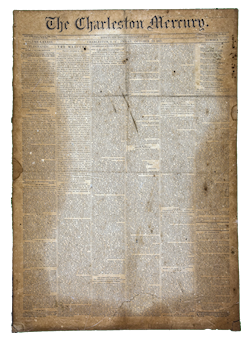March 3, 1863, The Charleston Mercury
The Savannah News of yesterday says:
Intelligence was received in official quarters on Saturday evening that the Yankee armada at Hilton Head was in motion, and that a large portion of it had left that harbor. Yesterday afternoon we learned, from what we conceive to be reliable sources, that twelve vessels had made their appearance in Mud River, near Venus’ Point, about eight miles below the city, and that two more were in Wilmington River, or Freeborn’s Cut. It was also reported that the enemy were landing on Skidaway Island, Wilmington Island, and the Isle of Hope. We were unable to satisfy ourself of the truth of the reported landings.
Later. – Thirteen vessels and three iron-clads, with a large number of troop barges, were in Ossabaw Sound last evening, which would indicate an advance on Beaulieu or on Genesis Point. The twelve vessels reported in Mud River are said to be in Wright’s River. It was very evident, from the activity among the military yesterday, that an attack on this city is expected at almost any hour, and that every precaution is being taken to prevent a surprise at any point. The troops are held in readiness to march at a moment’s notice.
The Republican gives us the following particulars of the loss of the steamer Nashville, or Rattlesnake:
The steamship Nashville and cargo were destroyed in the Great Ogeechee river on Saturday last by shell from the abolition fleet. She had on board about 700 bales compressed upland cotton, 75 barrels rosin, and 40 boxes tobacco. Having dropped down the river a short time since, she was ordered to change her anchorage and come up. On Friday, at 4, p.m., she weighed anchor, and while proceeding up, she grounded on a sand bar about a mile from Fort McAllister, at the point known as Seven Mile Bend, and in full view of the enemy. Every effort was made to get her off, but with no avail. At the next high tide, early Saturday morning, after making further efforts, but with no better success, she was abandoned by the officers and crew, the fleet, consisting of an iron-clad and three gunboats, being in motion. The iron-clad opened upon her from across the marsh, at a distance of about three-fourths of a mile, about 7 1/2 o’clock, a.m., assisted by the gunboats, and kept up a steady fire upon her till 10 o’clock, when one of their shells set her on fire. The flames reaching her magazine, she soon blew up. The fort kept up a fire upon the vandals, three shot from which, we are informed, striking the iron-clad. The fleet, having accomplished their object in destroying the Nashville withdrew to their old anchorage.
The Nashville had been employed previous to the war as a packet in the New York and Charleston trade. Since the war she has done good service in forcing the blockade. For several months past she has been lying in the Great Ogeechee River, near Arnold’s Landing, undergoing some alterations, having been purchased by a stock company, who had succeeded in obtaining from the Government letters of marque and reprisal for her under the name of the Rattlesnake. She was commanded by Capt. T. Harrison Baker, and mounted […..] and one 24 pounder.
